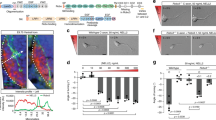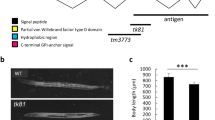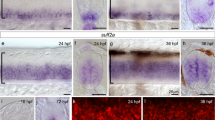Abstract
Commissural axons cross the ventral midline of the neural tube in a Slit-dependent manner. The underlying molecular mechanisms remain unclear. We found that the deubiquitinating enzyme USP33 interacts with the Robo1 receptor. USP33 was essential for midline crossing by commissural axons and for their response to Slit. Our results reveal a previously unknown role for USP33 in vertebrate commissural axon guidance and in Slit signaling.
This is a preview of subscription content, access via your institution
Access options
Subscribe to this journal
Receive 12 print issues and online access
$209.00 per year
only $17.42 per issue
Buy this article
- Purchase on Springer Link
- Instant access to full article PDF
Prices may be subject to local taxes which are calculated during checkout



Similar content being viewed by others
References
Tessier-Lavigne, M. & Goodman, C.S. Science 274, 1123–1133 (1996).
Dickson, B.J. Science 298, 1959–1964 (2002).
Guan, K.L. & Rao, Y. Nat. Rev. Neurosci. 4, 941–956 (2003).
Wong, K. et al. Cell 107, 209–221 (2001).
Li, Z. et al. J. Biol. Chem. 277, 4656–4662 (2002).
Li, Z. et al. Biochem. Biophys. Res. Commun. 294, 700–709 (2002).
Nijman, S.M. et al. Cell 123, 773–786 (2005).
Keino-Masu, K. et al. Cell 87, 175–185 (1996).
Okada, A. et al. Nature 444, 369–373 (2006).
Zou, Y., Stoeckli, E., Chen, H. & Tessier-Lavigne, M. Cell 102, 363–375 (2000).
Wu, J.Y. et al. Nature 410, 948–952 (2001).
Long, H. et al. Neuron 42, 213–223 (2004).
Sabatier, C. et al. Cell 117, 157–169 (2004).
Stoeckli, E.T. & Landmesser, L.T. Neuron 14, 1165–1179 (1995).
Piper, M. et al. Neuron 49, 215–228 (2006).
Acknowledgements
We thank Y. Zou and F. Murakami for generously providing the Sema3F construct and the antibody to Robo1, respectively, M. Katakura for support during this work and X. Chen for excellent technical support. This work has been supported by the James S. McDonnell Foundation (grant JSMF 220020180 to J.Y.W.) and the US National Institutes of Health (grants CA114197 and CA107193 to J.Y.W.).
Author information
Authors and Affiliations
Contributions
J.Y.-K. and M.K.-K. carried out the experiments. J.Y.-K., M.K.-K., J.Y.W. and Y.R. designed the experiments, analyzed the data and wrote the manuscript. G.W. provided the GFP-USP33 construct.
Corresponding authors
Supplementary information
Supplementary Text and Figures
Supplementary Figures 1–8 and Supplementary Methods (PDF 4965 kb)
Rights and permissions
About this article
Cite this article
Yuasa-Kawada, J., Kinoshita-Kawada, M., Wu, G. et al. Midline crossing and Slit responsiveness of commissural axons require USP33. Nat Neurosci 12, 1087–1089 (2009). https://doi.org/10.1038/nn.2382
Received:
Accepted:
Published:
Issue Date:
DOI: https://doi.org/10.1038/nn.2382
This article is cited by
-
srGAP1 mediates the migration inhibition effect of Slit2-Robo1 in colorectal cancer
Journal of Experimental & Clinical Cancer Research (2016)
-
srGAP1 mediates the migration inhibition effect of Slit2-Robo1 in colorectal cancer
Journal of Experimental & Clinical Cancer Research (2016)
-
USP33, a new player in lung cancer, mediates Slit-Robo signaling
Protein & Cell (2014)
-
The E3 ubiquitin ligase Mycbp2 genetically interacts with Robo2 to modulate axon guidance in the mouse olfactory system
Brain Structure and Function (2014)
-
The role of ubiquitylation in nerve cell development
Nature Reviews Neuroscience (2011)



